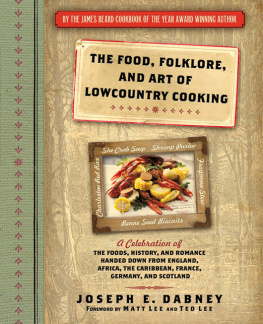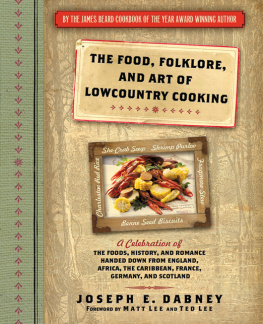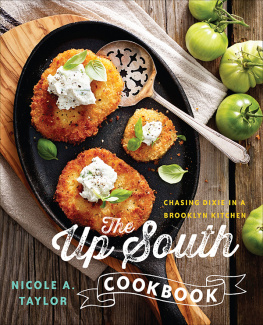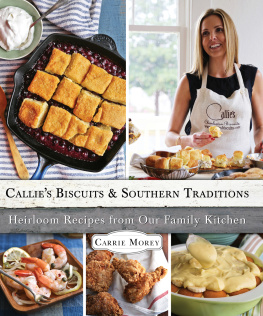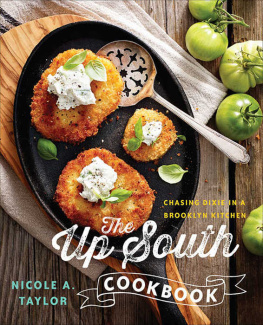

Recipes for Savoring the Heritage of Regional Southern Cooking
Paul Fehribach
THE UNIVERSITY OF CHICAGO PRESS
CHICAGO AND LONDON
Paul Fehribach is the co-owner and executive chef of Big Jones, a nationally acclaimed restaurant in Chicagos Andersonville neighborhood.
The University of Chicago Press, Chicago 60637
The University of Chicago Press, Ltd., London
2015 by The University of Chicago
All rights reserved. Published 2015.
Printed in the United States of America
24 23 22 21 20 19 18 17 16 15 1 2 3 4 5
ISBN-13: 978-0-226-20572-4 (cloth)
ISBN-13: 978-0-226-20586-1 (e-book)
DOI: 10.7208/chicago/9780226205861.001.0001
Library of Congress Cataloging-in-Publication Data
Fehribach, Paul, author.
The Big Jones cookbook: recipes for savoring the heritage of regional Southern cooking / Paul Fehribach.
pages; cm
Summary: A cookbook of Southern cuisine as featured at Big Jones Restaurant in Chicago, Illinois.
Includes bibliographical references and index.
ISBN 978-0-226-20572-4 (cloth: alk. paper)ISBN 0-226-20572-X(cloth: alk. paper)ISBN 978-0-226-20586-1 (e-book)
1. Cooking, AmericanSouthern style. 2. Big Jones (Restaurant: Chicago, Ill.) I. Title.
TX715.2.S68F44 2015
641.5975dc23
2014040936
This paper meets the requirements of ANSI/NISO Z39.48-1992 (Permanence of Paper).
Contents

Preface
I was the kid in school who read far more books than most would think wise for a young boy who had a wish to bond with his peers over such pursuits as sports, cars, or, as the years rolled on, girls. Like many households back then, ours had the complete set of Encyclopaedia Britannica, and I read those volumes with great relish, particularly the many details of the American storyfrom the earliest failed settlements to the Revolutionary War, the Indian Wars, the World Wars, and the Space Race that was still under way as I was coming of age. Id read the assigned history textbook by the end of the second week of class, then spend my ample spare time diving deeper into history, most often in those encyclopedia entries. It was the beginning of a lifelong journey, and Ive never outgrown that very basic curiosity. Many years later, it would come to define my cooking and become the creative engine of my first restaurant.
Its hard to pinpoint a moment in my life when I realized I wanted to be a chef, which to me means not only commanding a kitchen but feeding people, because it was something I wanted to do from a very young age. From the first day I could see over the counter, I wanted to be right at the heart of the kitchen, trying to figure it out, trying to learn what makes us tick: where we come from, why we do what we do, and especially how all of the delicious foods I loved came to the table.
My earliest memory of field-to-table cooking was on my familys farmstead east of Jasper, Indiana, along one of the branches of the old Buffalo Trace. My grandparents had a generations-old blackberry patch out along the edge of the tomato field. When I was four or five years old, several branches of the family gathered at the old farm, as we often did back then, and we kids were led to the blackberry patch by a few of our aunts. We spent the next couple of hours on a sunny July morning dodging barbs while picking ripe berries and occasionally getting a few into the gallon-size buckets we were charged with filling, rather than into our gluttonous mouths. By the time we had filled our buckets, our faces were covered in mottled swatches of purple.
We did eventually get some blackberries back to the house, and in what seemed like an instant the most rapturous pies emerged from the oventhick, sweet purplish lava bubbling up between the most perfectly golden crusts, the scent of the blackberry patch wafting through the kitchen as steam fluttered through the top vents of the crusts. Talk about heaven. I didnt realize it then, but that singular experience would later compel me to return to my roots in my cooking, always thinking of and emulating the farm that raised five generations of my family.
My dads mom died before I was old enough to remember her, but my many aunts helped maintain the farm kitchen, and I remember a few things about it, most notably the pantry, which was the size of many folks bedrooms. From a two-acre kitchen garden, my grandmother raised a family of thirteen, putting up her harvest every year in meticulously organized rows of jars containing everything from blackberry jelly and raspberry jam to pickled beets and all manner of pickled and sweet relishes. I didnt think anything of it at the time, but in retrospect I was witnessing a dying way of eating, one that Id eventually set out to revitalize for our worlds changing demographics and economic realities.
Since I grew up in a family that cooked at home, Ive come to advocate home cooking every chance I get, and my hope is that this book will inspire readers to cook at home more often, and perhaps more ambitiously. Realistically, however, for many of us the idea of cooking at home most days of the week is a fantasy, with so many households depending on two incomes, having kids in school, along with the many other pressures of everyday life. The reality for many people is that cooking has become a recreational pastime for weekends or leisure time. Many adventurous eaters make a Saturday out of a trip to the farmers market and then putting their market ingredients to use with inspiration from cookbooks, food television shows, or family heirloom recipes. Time well spent in my opinion. Still, eating many meals out is here to stay.

Even though home cooking is a tradition that is rooted in our collective agrarian history, the everyday home-cooked meal is a thing of the past for most people. That does not, however, mean we cant enjoy that same spirit of cooking when we dine out. As restaurants become the family table of our culture, we chefs and our staffs have begun to play the roles of moms and grandmas and dads and the eager sons and daughters pitching in, and our network of farms is our homestead. What Ive sought to do is create a cuisine that is rooted in the ethics of my grandparents farm, where no food was ever served that they themselves or someone they personally knew did not raise, grow, shoot, or forage. Its a simple concept but challenging nonetheless, as our menus must change as frequently as the weatherbut this is how it is when you eat close to the land, as we all did in generations past and as we all can do again. We dont have to surrender to mass-produced foods of dubious origins. We can create a new family table. This has always been my dream: to offer people food as pure and unadulterated as that which raised generations of my family on that farm with the blackberry patch.
A Growing Obsession
In retrospect, it seems like a question I should have been prepared to answer, but when we opened Big Jones, I wasnt ready for it. The question every food writer, journalist, and many of our customers asked was, Why did you decide to do Southern food? It took me aback at first, because to me the answer was obviouswhy not cook Southern food? In fact, I hadnt thought much about it, other than questioning whether I could make a go of such a restaurant in Chicago. But of course people wanted to know why.
Next page


